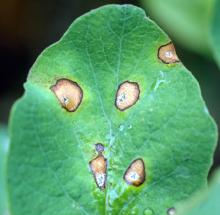Cause Many fungi are capable of causing necrotic leaf spots on snowberry. Of these, Phyllosticta symphoricarpi, Ascochyta tenerrima, Septoria symphoricarpi, and Sphaceloma symphoricarpi (anthracnose) are reported as widespread throughout Northwestern States. In addition, Septoria signalensis has been confirmed in Idaho; however, Septoria symphoricarpi is likely the most significant leaf spot pathogen of this genus for the region. Most fungal leaf spots are favored by wet weather that keeps leaves wet for extended periods of time. They generally survive unfavorable conditions in plant debris.
Colletotrichum gloeosporioides has also been reported as causing leaf spots. Aschochyta tenerrima has been reported on this genus in Washington and is widespread in North America and Europe. Passalora symphoricarpi (formerly Cercospora symphoricarpi) is reported as a foliar pathogen in central and Eastern North America.
Symptoms Spots form as leaves emerge in the spring; first as dark brown lesions that become bleached and necrotic in the centers as the lesion expands. Lesions may coalesce over time as the disease develops. Black fruiting bodies (pycnidia or acervuli) may form within necrotic areas of advanced lesions.
Anthracnose is characterized with lesions on green stems, flowers, and fruits in addition to leaves. In severe cases infected parts may become distorted. Lesions on fruits are sunken, circular, and pink-brown colored, often resulting in the mummification of the berry.
Cultural control
- Remove and destroy spotted leaves and/or plants as they appear.
- Avoid over-crowding by adjacent plants.
- Remove fallen leaves and plant debris.
- Avoid overhead irrigation, or water such that plants are not wet for extended periods of time.
Chemical control Spray periodically during growing season especially if leaf spots were abundant in the previous year. There are no fungicides specifically registered for this crop; however, copper-based products (Group M1 fungicides) or Group M3 fungicides have been recommended in some references. Many labels will allow ornamental use. Test first on a small section before applying on the whole plant to evaluate possible phytotoxicity.
References Pirone, P.P. 1978. Diseases and Pest of Ornamental Plants 5th ed. John Wiley and Sons, Inc.
Sinclair, W.A. and Lyon, H.H. 2005. Diseases of trees and shrubs, 2nd ed. Cornell University Press.


